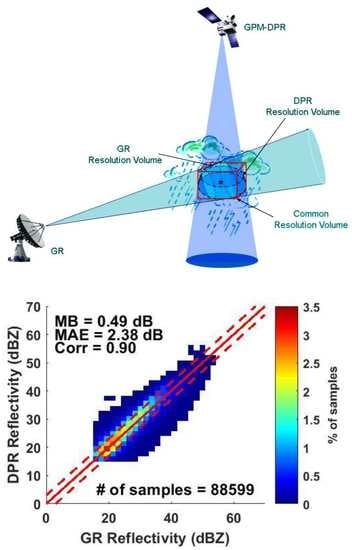Cross-Validation of Observations between the GPM Dual-Frequency Precipitation Radar and Ground Based Dual-Polarization Radars
Abstract
1. Introduction
2. Instruments, Datasets and Analysis Methodology
2.1. The GPM Satellite: Dual-Frequency Radar
2.2. Ground Validation Radar: NEXRAD
2.3. Theoretical Simulations of Reflectivities at S, Ku, and Ka-Band
2.4. Volume Matching Methodology
3. Results and discussions
3.1. Comparison of Radar Reflectivity
3.2. Absolute Calibration of Ground Radars with Respect to DPR
3.3. Comparison of Instantaneous Rainfall Rate
4. Summary and Conclusions
Author Contributions
Funding
Acknowledgments
Conflicts of Interest
References
- Kummerow, C.; Barnes, W.; Kozu, T.; Shiue, J.; Simpson, J. The tropical rainfall measuring mission (TRMM) sensor package. J. Atmos. Ocean. Technol. 1998, 15, 809–817. [Google Scholar] [CrossRef]
- Liu, Z.; Ostrenga, D.; Teng, W.; Kempler, S. Tropical Rainfall Measuring Mission (TRMM) precipitation data and services for research and applications. Bull. Am. Meteorol. Soc. 2012, 93, 1317–1325. [Google Scholar] [CrossRef]
- Hou, A.Y.; Kakar, R.K.; Neeck, S.; Azarbarzin, A.A.; Kummerow, C.D.; Kojima, M.; Oki, R.; Nakamura, K.; Iguchi, T. The global precipitation measurement mission. Bull. Am. Meteorol. Soc. 2014, 95, 701–722. [Google Scholar] [CrossRef]
- Furukawa, K.; Nio, T.; Konishi, T.; Oki, R.; Masaki, T.; Kubota, T.; Iguchi, T.; Hanado, H. Current status of the dual-frequency precipitation radar on the global precipitation measurement core spacecraft. In Sensors, Systems, and Next-Generation Satellites XIX; International Society for Optics and Photonics: Bellingham, MA, USA, 2015; Volume 9639. [Google Scholar]
- Senbokuva, Y.; Satoh, S.; Furukawa, K.; Koiima, M.; Hanado, H.; Takahashi, N.; Iguchi, T.; Nakamura, K. Development of the spaceborne dual-frequency precipitation radar for the Global Precipitation Measurement mission. In Proceedings of the 2004 IEEE International Geoscience and Remote Sensing Symposium, IGARSS’04, Anchorage, AK, USA, 20–24 September 2004; IEEE: Piscataway, NJ, USA, 2004; Volume 5. [Google Scholar]
- Draper, D.W.; Newell, D.A.; Wentz, F.J.; Krimchansky, S.; Skofronick-Jackson, G.M. The global precipitation measurement (GPM) microwave imager (GMI): Instrument overview and early on-orbit performance. IEEE J. Sel. Top. Appl. Earth Obs. Remote Sens. 2015, 8, 3452–3462. [Google Scholar] [CrossRef]
- Liao, L.; Meneghini, R. A study on the feasibility of dual-wavelength radar for identification of hydrometeor phases. J. Appl. Meteorol. Climatol. 2011, 50, 449–456. [Google Scholar] [CrossRef]
- Le, M.; Chandrasekar, V.; Biswas, S. An algorithm to identify surface snowfall from gpm dpr observations. IEEE Trans. Geosci. Remote Sens. 2017, 55, 4059–4071. [Google Scholar] [CrossRef]
- Chandrasekar, V.; Hou, A.; Smith, E.; Bringi, V.N.; Rutledge, S.A.; Gorgucci, E.; Petersen, W.A.; Jackson, G.S. Potential role of dual-polarization radar in the validation of satellite precipitation measurements: Rationale and opportunities. Bull. Am. Meteorol. Soc. 2008, 89, 1127–1146. [Google Scholar] [CrossRef]
- Iguchi, T.; Seto, S.; Meneghini, R.; Yoshida, N.; Awaka, J.; Kubota, T. GPM/DPR Level-2 Algorithm Theoretical Basis Document; Tech. Rep.; NASA Goddard Space Flight Center: Greenbelt, MD, USA, 2010.
- Iguchi, T.; Seto, S.; Meneghini, R.; Yoshida, N.; Awaka, J.; Kubota, T.; Kozu, T.; Chandra, V.; Le, M.; Liao, L.; et al. An overview of the precipitation retrieval algorithm for the dual-frequency precipitation radar (DPR) on the global precipitation measurement (GPM) mission’s core satellite. In Earth Observing Missions and Sensors: Development, Implementation, and Characterization II; International Society for Optics and Photonics: Bellingham, MA, USA, 2012; Volume 8528. [Google Scholar]
- Kubota, T.; Yoshida, N.; Urita, S.; Iguchi, T.; Seto, S.; Meneghini, R.; Awaka, J.; Hanado, H.; Kida, S.; Oki, R. Evaluation of precipitation estimates by at-launch codes of GPM/DPR algorithms using synthetic data from TRMM/PR observations. IEEE J. Sel. Top. Appl. Earth Obs. Remote Sens. 2014, 7, 3931–3944. [Google Scholar] [CrossRef]
- Toyoshima, K.; Masunaga, H.; Furuzawa, F.A. Early evaluation of Ku-and Ka-band sensitivities for the global precipitation measurement (GPM) dual-frequency precipitation radar (DPR). Sola 2015, 11, 14–17. [Google Scholar] [CrossRef]
- Khajonrat, D.; Chandrasekar, V. Simulation of spaceborne radar observations of precipitation: Application to GPM-DPR. In Proceedings of the IEEE International Geoscience and Remote Sensing Symposium, IGARSS 2008, Boston, MA, USA, 7–11 July 2008; IEEE: Piscataway, NJ, USA, 2008; Volume 4. [Google Scholar]
- Chandrasekar, V.; Khajonrat, D. Simulation of space-borne radar observations of precipitation at ku and ka band. Preprints. In Proceedings of the 34th Conference on Radar Meteorology, Williamsburg, VA, USA, 5–9 October 2009; Volume 7. [Google Scholar]
- Speirs, P.; Gabella, M.; Berne, A. A comparison between the GPM dual-frequency precipitation radar and ground-based radar precipitation rate estimates in the Swiss Alps and Plateau. J. Hydrometeorol. 2017, 18, 1247–1269. [Google Scholar] [CrossRef]
- Gabella, M.; Speirs, P.; Hamann, U.; Germann, U.; Berne, A. Measurement of Precipitation in the Alps Using Dual-Polarization C-Band Ground-Based Radars, the GPM Spaceborne Ku-Band Radar, and Rain Gauges. Remote Sens. 2017, 9, 1147. [Google Scholar] [CrossRef]
- Biswas, S.K.; Chandrasekar, V. Cross validation of observations from GPM dual-frequency precipitation radar with S-band ground radar measurements over the Dallas—Fort worth region. In Proceedings of the 2017 IEEE International Geoscience and Remote Sensing Symposium (IGARSS), Fort Worth, TX, USA, 23–28 July 2017. [Google Scholar]
- Warren, R.A.; Protat, A.; Siems, S.T.; Ramsay, H.A.; Louf, V.; Manton, M.J.; Kane, T.A. Calibrating ground-based radars against TRMM and GPM. J. Atmos. Ocean. Technol. 2018, 35, 323–346. [Google Scholar] [CrossRef]
- Crisologo, I.; Warren, R.A.; Mühlbauer, K.; Heistermann, M. Enhancing the consistency of spaceborne and ground-based radar comparisons by using beam blockage fraction as a quality filter. Atmos. Meas. Tech. 2018, 11, 5223–5236. [Google Scholar] [CrossRef]
- Panegrossi, G.; Casella, D.; Dietrich, S.; Marra, A.C.; Sanò, P.; Mugnai, A.; Baldini, L.; Roberto, N.; Adirosi, E.; Cremonini, R.; et al. Use of the GPM constellation for monitoring heavy precipitation events over the Mediterranean region. IEEE J. Sel. Top. Appl. Earth Obs. Remote Sens. 2016, 9, 2733–2753. [Google Scholar] [CrossRef]
- Kidd, C.; Matsui, T.; Chern, J.; Mohr, K.; Kummerow, C.; Randel, D. Global precipitation estimates from cross-track passive microwave observations using a physically based retrieval scheme. J. Hydrometeorol. 2016, 17, 383–400. [Google Scholar] [CrossRef]
- Derin, Y.; Anagnostou, E.; Anagnostou, M.N.; Kalogiros, J.; Casella, D.; Marra, A.C.; Panegrossi, G.; Sanò, P. Passive microwave rainfall error analysis using high-resolution x-band dual-polarization radar observations in complex terrain. IEEE Trans. Geosci. Remote Sens. 2018, 56, 2565–2586. [Google Scholar] [CrossRef]
- Anagnostou, M.N.; Kalogiros, J.; Nikolopoulos, E.; Derin, Y.; Anagnostou, E.N.; Borga, M. Satellite rainfall error analysis with the use of high-resolution X-band dual-polarization radar observations over the Italian Alps. In Perspectives on Atmospheric Sciences; Springer: Cham, Switzerland, 2017; pp. 279–286. [Google Scholar]
- Schwaller, M.R.; Morris, K.R. A ground validation network for the global precipitation measurement mission. J. Atmos. Ocean. Technol. 2011, 28, 301–319. [Google Scholar] [CrossRef]
- NASA/JAXA. Precipitation Measurement Missions: Global Precipitation Mission (GPM) Ground Validation System. 2015. Available online: https://pmm.nasa.gov/sites/default/files/document_files/Val_Network_Users_Guide_Vol_2_Nov2015.pdf (accessed on 31 July 2018).
- Seto, S.; Iguchi, T. Intercomparison of attenuation correction methods for the GPM dual-frequency precipitation radar. J. Atmos. Ocean. Technol. 2015, 32, 915–926. [Google Scholar] [CrossRef]
- Bolen, S.M.; Chandrasekar, V. Methodology for aligning and comparing spaceborne radar and ground-based radar observations. J. Atmos. Ocean. Technol. 2003, 20, 647–659. [Google Scholar] [CrossRef]
- Le, M.; Chandrasekar, V. Raindrop size distribution retrieval from dual-frequency and dual-polarization radar. IEEE Trans. Geosci. Remote Sens. 2012, 50, 1748–1758. [Google Scholar] [CrossRef]
- Le, M.; Chandrasekar, V.; Biswas, S. Evaluation and Validation of GPM Dual-Frequency Classification Module after Launch. J. Atmos. Ocean. Technol. 2016, 33, 2699–2716. [Google Scholar] [CrossRef]
- Biswas, S.K.; Le, M.; Chandrasekar, V. Identification of Snow from GPM-DPR observations and cross validation with S-Band Ground Radar dual polarization measurements. In Proceedings of the 2017 XXXIInd General Assembly and Scientific Symposium of the International Union of Radio Science (URSI GASS), Montreal, QC, Canada, 19–26 August 2017. [Google Scholar]
- NASA/JAXA. Global Precipitation Measurement Precipitation Processing System: File Specification for GPM Products. 2018. Available online: https://pps.gsfc.nasa.gov/Documents/filespec.GPM_V5.pdf (accessed on 31 July 2018).
- NASA/JAXA. Global Precipitation Measurement Precipitation Processing System: Release Notes for the DPR V5 Level 2 Products. 2017. Available online: https://pps.gsfc.nasa.gov/Documents/V05ReleaseNotes/Caveats_DPRL2_productV05.pdf (accessed on 31 July 2018).
- Klazura, G.E.; Imy, D.A. A description of the initial set of analysis products available from the NEXRAD WSR-88D system. Bull. Am. Meteorol. Soc. 1993, 74, 1293–1312. [Google Scholar] [CrossRef]
- Maddox, R.A.; Zhang, J.; Gourley, J.J.; Howard, K.W. Weather radar coverage over the contiguous United States. Weather Forecast. 2002, 17, 927–934. [Google Scholar] [CrossRef]
- Ryzhkov, A.V.; Giangrande, S.E.; Melnikov, V.M.; Schuur, T.J. Calibration issues of dual-polarization radar measurements. J. Atmos. Ocean. Technol. 2005, 22, 1138–1155. [Google Scholar] [CrossRef]
- Waterman, P.C. Symmetry, unitarity, and geometry in electromagnetic scattering. Phys. Rev. D 1971, 3, 825. [Google Scholar] [CrossRef]
- Thurai, M.; Huang, G.J.; Bringi, V.N.; Randeu, W.L.; Schönhuber, M. Drop shapes, model comparisons, and calculations of polarimetric radar parameters in rain. J. Atmos. Ocean. Technol. 2007, 24, 1019–1032. [Google Scholar] [CrossRef]
- Testud, J.; Oury, S.; Black, R.A.; Amayenc, P.; Dou, X. The concept of “normalized” distribution to describe raindrop spectra: A tool for cloud physics and cloud remote sensing. J. Appl. Meteorol. 2001, 40, 1118–1140. [Google Scholar] [CrossRef]
- Baldini, L.; Chandrasekar, V.; Moisseev, D. Microwave radar signatures of precipitation from S band to Ka band: application to GPM mission. Eur. J. Remote Sens. 2012, 45, 75–88. [Google Scholar] [CrossRef]
- Bolen, S.M.; Chandrasekar, V. Quantitative Cross Validation of Space-Based and Ground-Based Radar Observations. J. Appl. Meteorol. 2000, 39, 2071–2079. [Google Scholar] [CrossRef]
- Anagnostou, E.N.; Morales, C.A.; Dinku, T. The use of TRMM precipitation radar observations in determining ground radar calibration biases. J. Atmos. Ocean. Technol. 2001, 18, 616–628. [Google Scholar] [CrossRef]
- Liao, L.; Meneghini, R.; Iguchi, T. Comparisons of rain rate and reflectivity factor derived from the TRMM precipitation radar and the WSR-88D over the Melbourne, Florida, site. J. Atmos. Ocean. Technol. 2001, 18, 1959–1974. [Google Scholar] [CrossRef]
- Barnes, S.L. A technique for maximizing details in numerical weather map analysis. J. Appl. Meteorol. 1964, 3, 396–409. [Google Scholar] [CrossRef]
- Meneghini, R.; Iguchi, T.; Kozu, T.; Liao, L.; Okamoto, K.I.; Jones, J.A.; Kwiatkowski, J. Use of the surface reference technique for path attenuation estimates from the TRMM precipitation radar. J. Appl. Meteorol. 2000, 39, 2053–2070. [Google Scholar] [CrossRef]
- Le, M.; Chandrasekar, V. Precipitation type classification method for dual-frequency precipitation radar (DPR) onboard the GPM. IEEE Trans. Geosci. Remote Sens. 2013, 51, 1784–1790. [Google Scholar] [CrossRef]
- Iguchi, T.; Kozu, T.; Meneghini, R.; Awaka, J.; Okamoto, K.I. Rain-profiling algorithm for the TRMM precipitation radar. J. Appl. Meteorol. 2000, 39, 2038–2052. [Google Scholar] [CrossRef]
- Konrad, C.E.; Perry, L.B. Relationships between tropical cyclones and heavy rainfall in the Carolina region of the USA. Int. J. Climatol. 2010, 30, 522–534. [Google Scholar] [CrossRef]
- Chen, H.; Chandrasekar, V. The quantitative precipitation estimation system for Dallas–Fort Worth (DFW) urban remote sensing network. J. Hydrol. 2015, 531, 259–271. [Google Scholar] [CrossRef]
- Omranian, E.; Sharif, H.; Tavakoly, A. How well can global precipitation measurement (GPM) capture hurricanes? Case study: Hurricane Harvey. Remote Sens. 2018, 10, 1150. [Google Scholar] [CrossRef]
- Omranian, E.; Sharif, H.O. Evaluation of the Global Precipitation Measurement (GPM) Satellite Rainfall Products over the Lower Colorado River Basin, Texas. JAWRA J. Am. Water Resour. Assoc. 2018, 54, 882–898. [Google Scholar] [CrossRef]
- Islam, T.; Rico-Ramirez, M.A.; Han, D.; Srivastava, P.K.; Ishak, A.M. Performance evaluation of the TRMM precipitation estimation using ground-based radars from the GPM validation network. J. Atmos. Sol.-Terr. Phys. 2012, 77, 194–208. [Google Scholar] [CrossRef]

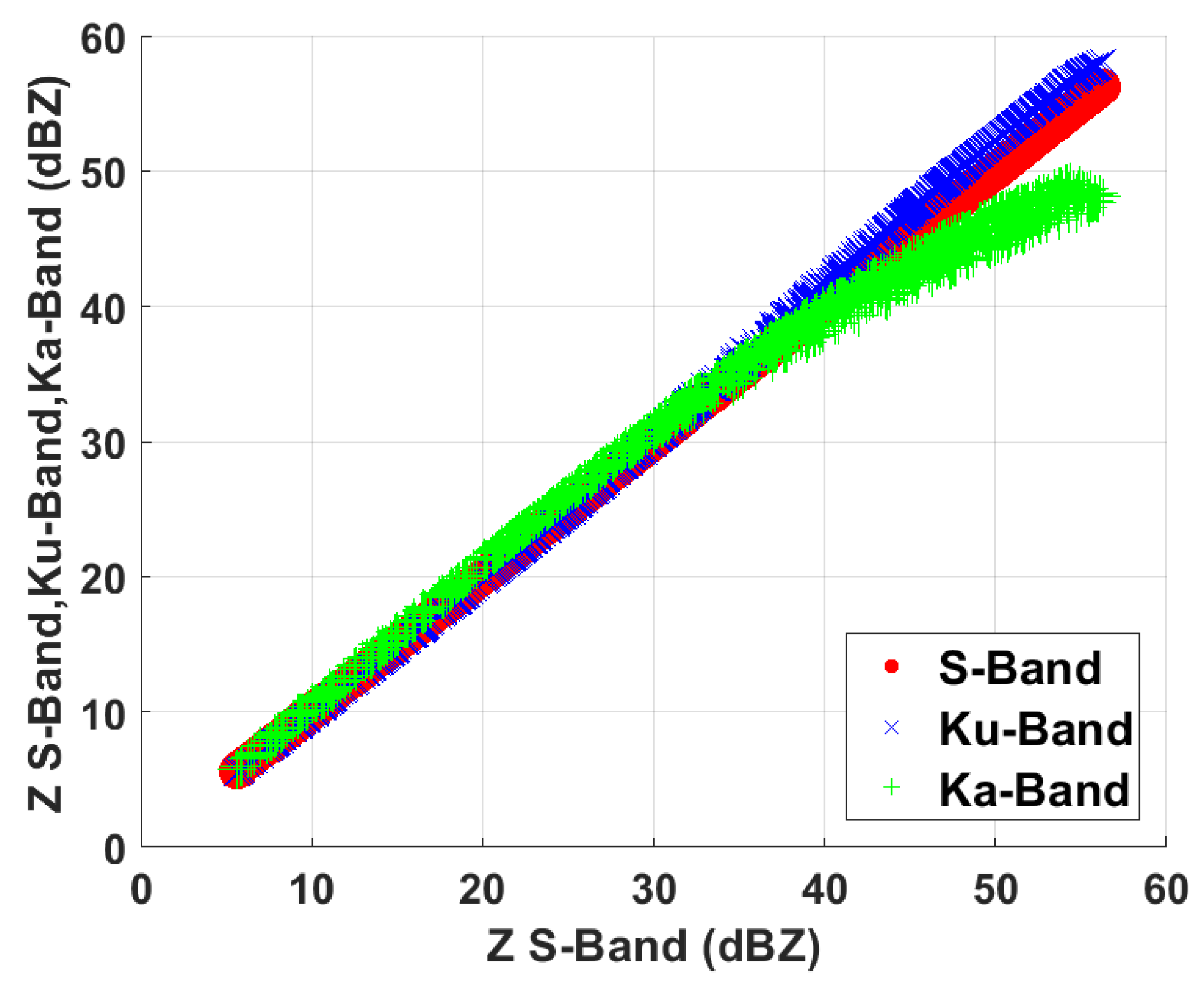
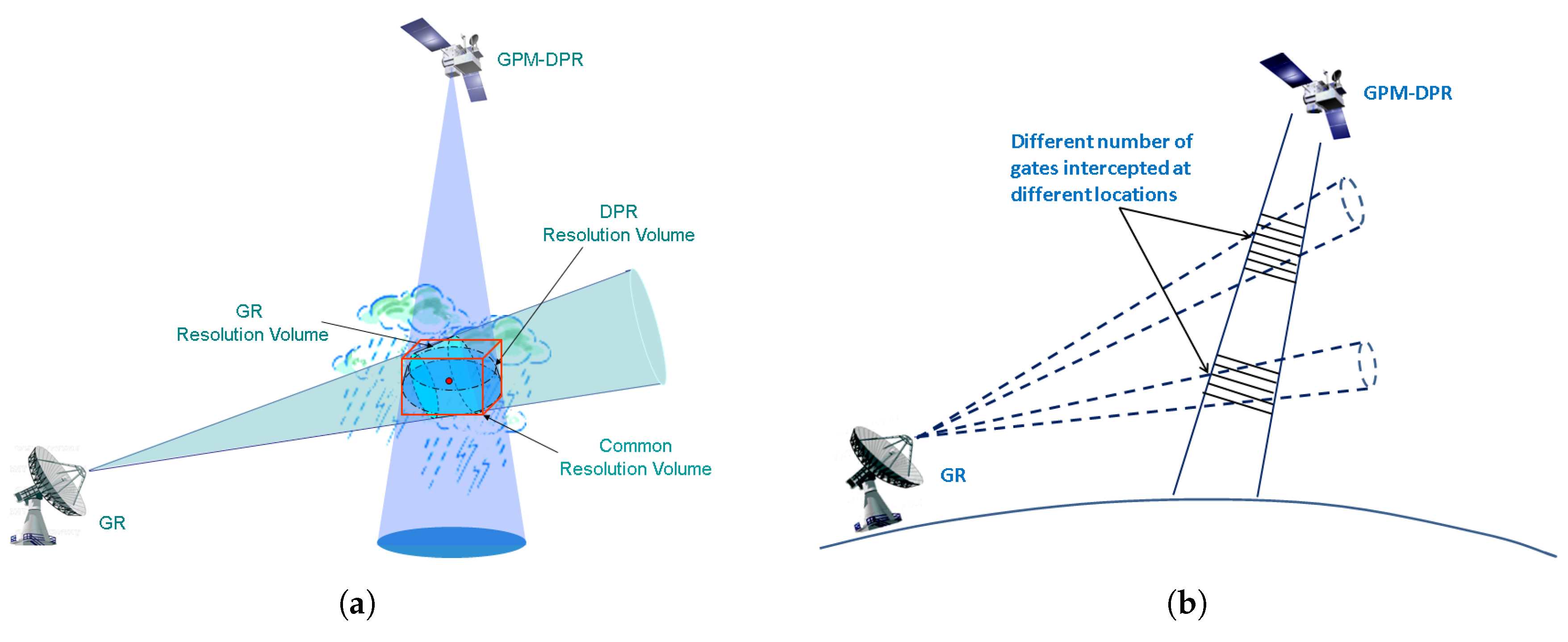

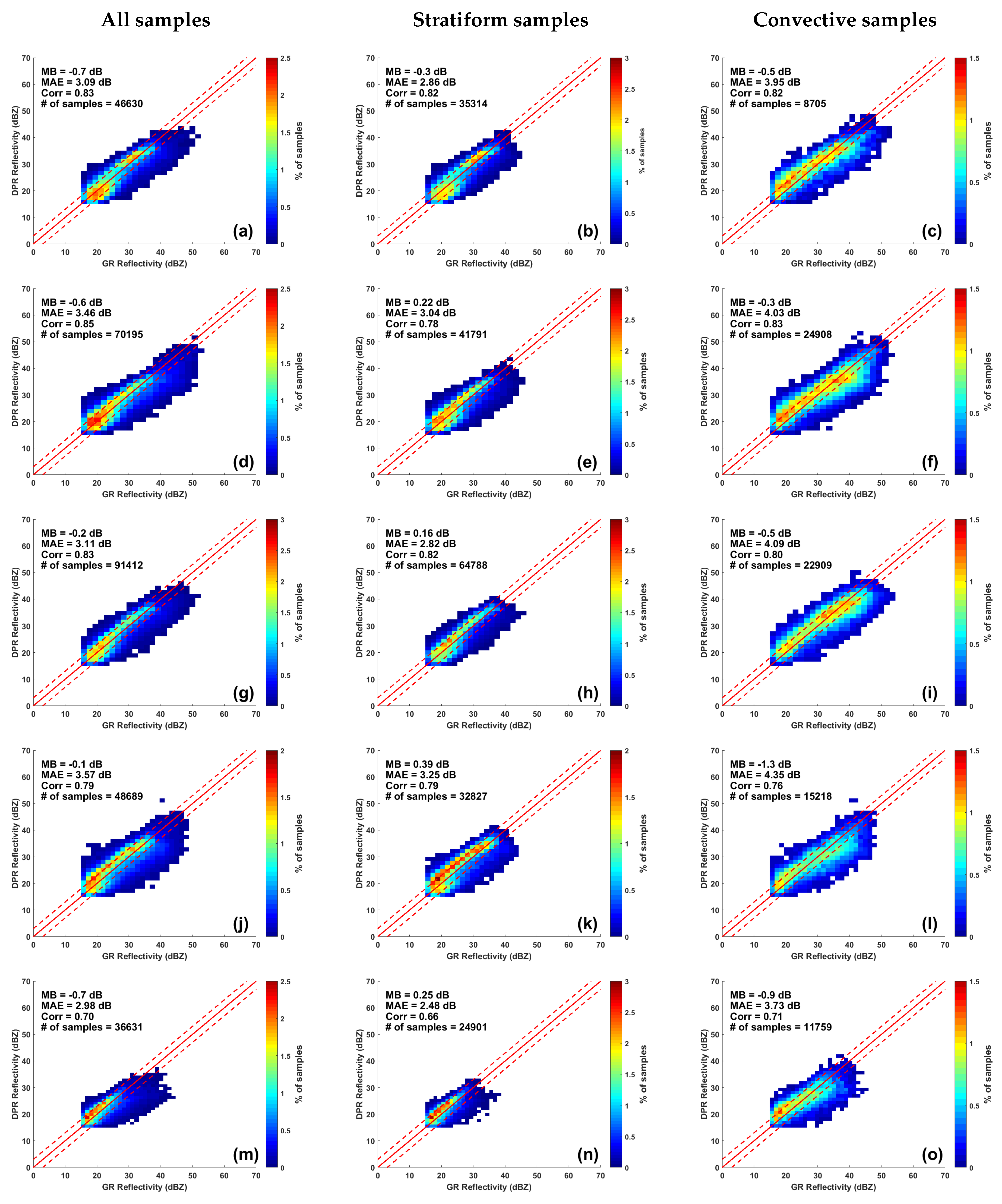
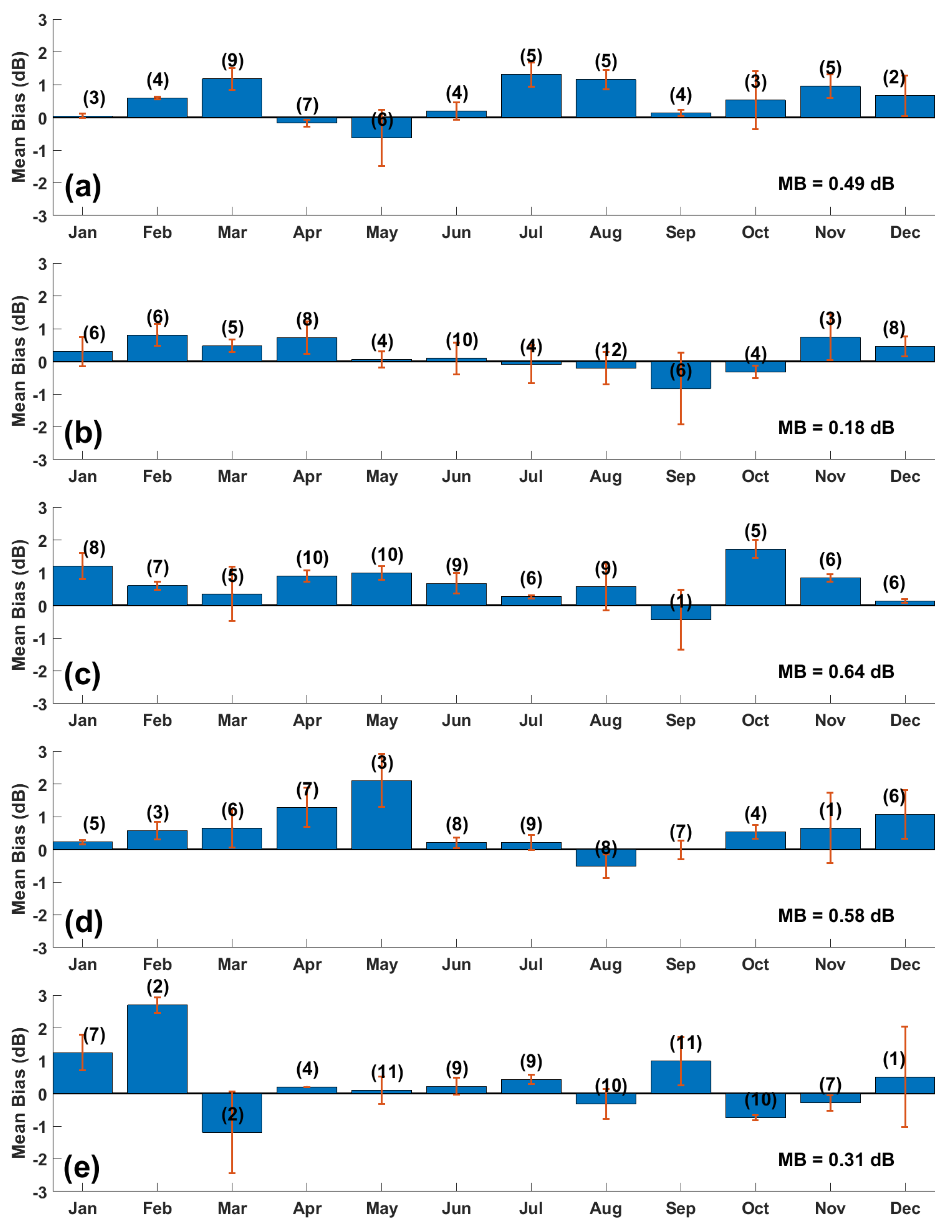
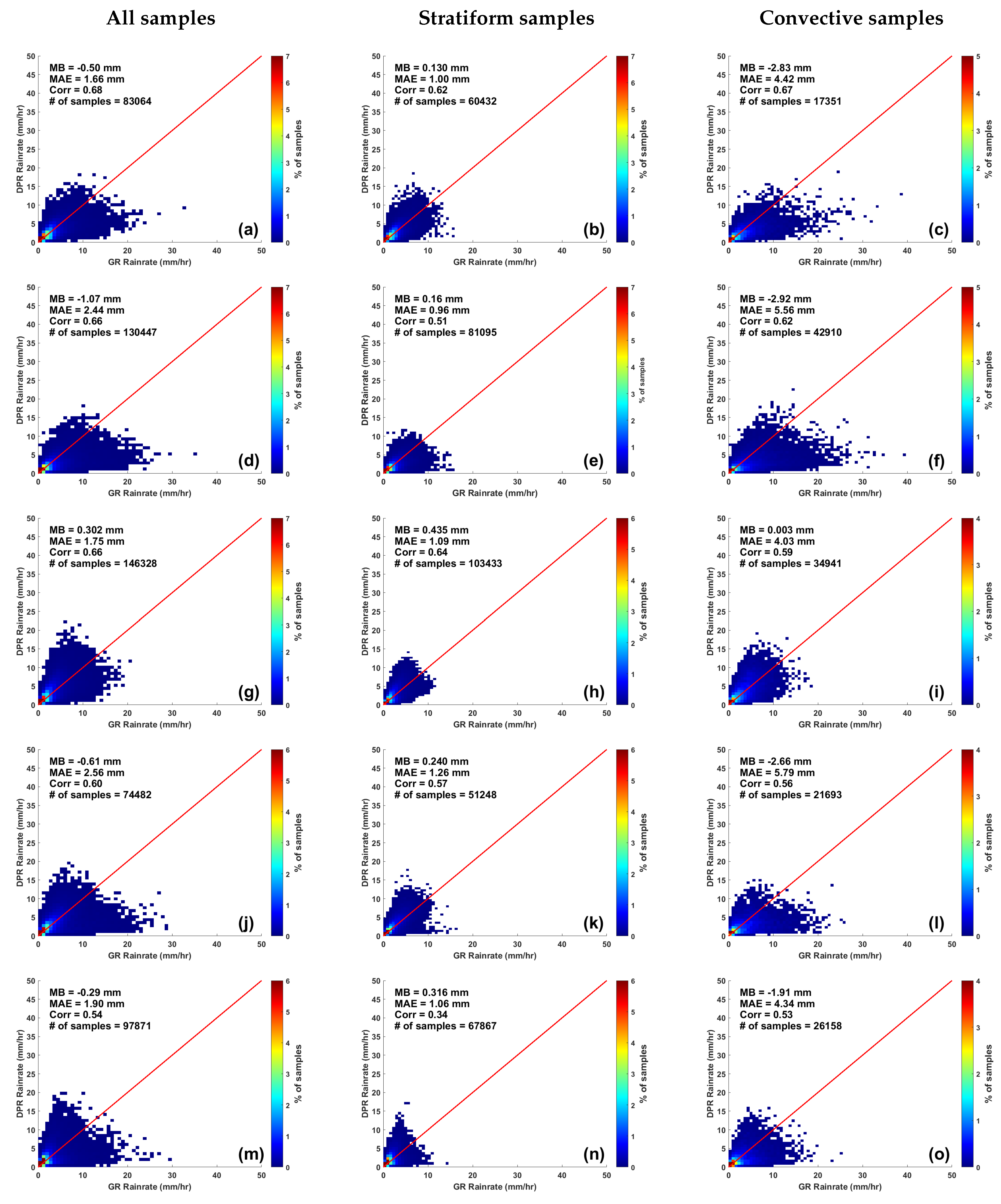
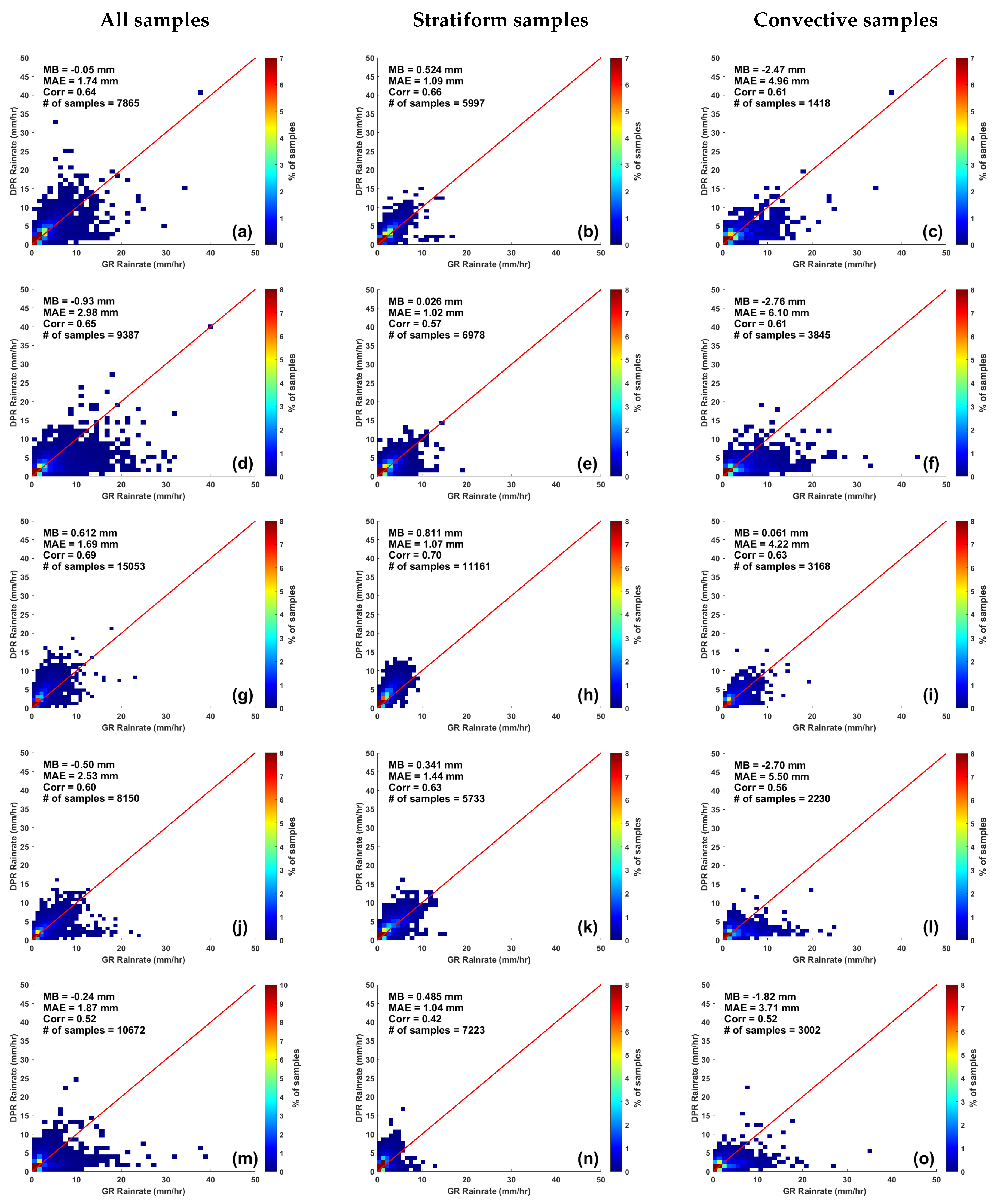
| Name | Location | Lat (deg.) | Lon (deg.) | Altitude (m) |
|---|---|---|---|---|
| KFWS | Dallas/Ft. Worth, TX | 32.5731 | −97.3031 | 208.17 |
| KHGX | Houston/Galveston, TX | 29.4719 | −95.0792 | 5.48 |
| KSHV | Shreveport, LA | 32.4508 | −93.8414 | 83.21 |
| KLIX | New Orleans, LA | 30.3367 | −89.8256 | 7.31 |
| KMLB | Melbourne, FL | 28.1133 | −28.6542 | 10.66 |
| All Samples | Stratiform Samples | Convective Samples | ||||||||||||||||
|---|---|---|---|---|---|---|---|---|---|---|---|---|---|---|---|---|---|---|
| Ku Band (dBZ) | Ka Band (dBZ) | Ku Band (dBZ) | Ka Band (dBZ) | Ku Band (dBZ) | Ka Band (dBZ) | |||||||||||||
| Radar | MB | MAE | Corr | MB | MAE | Corr | MB | MAE | Corr | MB | MAE | Corr | MB | MAE | Corr | MB | MAE | Corr |
| KFWS | 0.49 | 2.38 | 0.90 | −0.7 | 3.09 | 0.83 | 0.67 | 2.21 | 0.89 | −0.3 | 2.86 | 0.82 | 0.16 | 3.04 | 0.88 | −0.5 | 3.95 | 0.82 |
| KHGX | 0.18 | 2.44 | 0.91 | −0.6 | 3.46 | 0.85 | 0.39 | 2.10 | 0.88 | 0.22 | 3.04 | 0.78 | −0.3 | 3.08 | 0.89 | −0.3 | 4.03 | 0.83 |
| KSHV | 0.64 | 2.40 | 0.90 | −0.2 | 3.11 | 0.83 | 0.61 | 2.06 | 0.90 | 0.16 | 2.82 | 0.82 | 0.0 | 3.26 | 0.85 | −0.5 | 4.09 | 0.80 |
| KLIX | 0.58 | 2.67 | 0.88 | −0.1 | 3.57 | 0.79 | 0.67 | 2.30 | 0.89 | 0.39 | 3.25 | 0.79 | 0.45 | 3.49 | 0.84 | −1.3 | 4.35 | 0.76 |
| KMLB | 0.31 | 2.58 | 0.87 | −0.7 | 2.98 | 0.70 | 0.66 | 2.31 | 0.83 | 0.25 | 2.48 | 0.66 | −0.4 | 3.28 | 0.86 | −0.9 | 3.73 | 0.71 |
| All Samples | Stratiform Samples | Convective Samples | ||||||||||||||||
|---|---|---|---|---|---|---|---|---|---|---|---|---|---|---|---|---|---|---|
| Single Frequency Product (mm/h) | Dual Frequency Product (mm/h) | Single Frequency Product (mm/h) | Dual Frequency Product (mm/h) | Single Frequency Product (mm/h) | Dual Frequency Product (mm/h) | |||||||||||||
| Radar | MB | MAE | Corr | MB | MAE | Corr | MB | MAE | Corr | MB | MAE | Corr | MB | MAE | Corr | MB | MAE | Corr |
| KFWS | −0.50 | 1.66 | 0.68 | −0.05 | 1.74 | 0.64 | 0.13 | 1.00 | 0.62 | 0.52 | 1.09 | 0.66 | −2.83 | 4.42 | 0.67 | −2.47 | 4.96 | 0.61 |
| KHGX | −1.07 | 2.44 | 0.66 | −0.93 | 2.98 | 0.65 | 0.16 | 0.96 | 0.51 | 0.02 | 1.02 | 0.57 | −2.92 | 5.56 | 0.62 | −2.76 | 6.10 | 0.61 |
| KSHV | 0.30 | 1.75 | 0.66 | 0.61 | 1.69 | 0.69 | 0.43 | 1.09 | 0.64 | 0.81 | 1.07 | 0.7 | 0.00 | 4.03 | 0.59 | 0.06 | 4.22 | 0.63 |
| KLIX | −0.61 | 2.56 | 0.60 | −0.5 | 2.53 | 0.6 | 0.24 | 1.26 | 0.57 | 0.34 | 1.44 | 0.63 | −2.66 | 5.79 | 0.56 | −2.70 | 5.50 | 0.56 |
| KMLB | −0.29 | 1.90 | 0.54 | −0.24 | 1.87 | 0.52 | 0.31 | 1.06 | 0.34 | 0.48 | 1.04 | 0.42 | −1.91 | 4.34 | 0.53 | −1.82 | 3.71 | 0.52 |
© 2018 by the authors. Licensee MDPI, Basel, Switzerland. This article is an open access article distributed under the terms and conditions of the Creative Commons Attribution (CC BY) license (http://creativecommons.org/licenses/by/4.0/).
Share and Cite
Biswas, S.K.; Chandrasekar, V. Cross-Validation of Observations between the GPM Dual-Frequency Precipitation Radar and Ground Based Dual-Polarization Radars. Remote Sens. 2018, 10, 1773. https://doi.org/10.3390/rs10111773
Biswas SK, Chandrasekar V. Cross-Validation of Observations between the GPM Dual-Frequency Precipitation Radar and Ground Based Dual-Polarization Radars. Remote Sensing. 2018; 10(11):1773. https://doi.org/10.3390/rs10111773
Chicago/Turabian StyleBiswas, Sounak Kumar, and V. Chandrasekar. 2018. "Cross-Validation of Observations between the GPM Dual-Frequency Precipitation Radar and Ground Based Dual-Polarization Radars" Remote Sensing 10, no. 11: 1773. https://doi.org/10.3390/rs10111773
APA StyleBiswas, S. K., & Chandrasekar, V. (2018). Cross-Validation of Observations between the GPM Dual-Frequency Precipitation Radar and Ground Based Dual-Polarization Radars. Remote Sensing, 10(11), 1773. https://doi.org/10.3390/rs10111773



